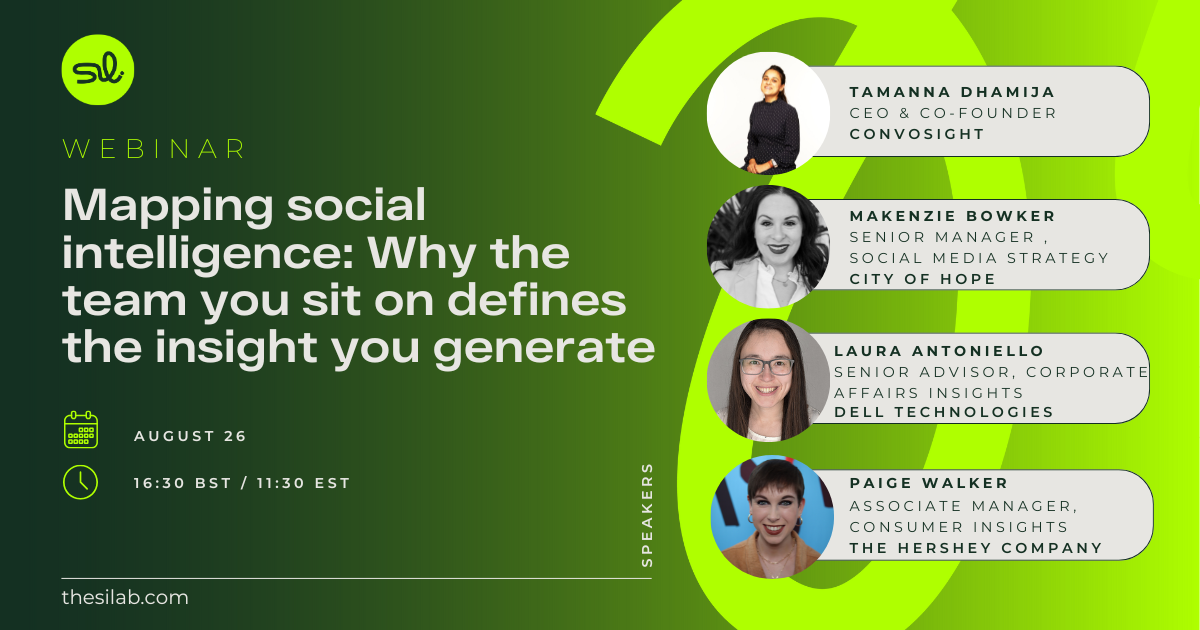
The Difference Between Social Listening and Social Intelligence
The words we use to describe what we do have an impact on our projects and what we get out of them. One of our biggest bugbears is the misuse of the terms social listening and social intelligence. One isn’t better than the other, but they are different. Here’s how...
What is social listening?
Social listening is the process of tracking mentions of a brand, product or competitor online. That can mean tracking direct mentions of a brand or product for the purpose of measuring customer feedback or it can be watching the conversation for discussion around a topic. You’ll also see social listening called social media monitoring or social media analytics and it typically sits as a function within marketing, often as an extension of social media management.
How do you do social listening?
Social listening is done in real-time, using a tool or software and the output of a social listening function is usually reports, graphs, and word clouds, often as a monthly or quarterly comparison to measure the success of campaigns, brand health, or product feedback.
Social listening is an ongoing practice of tracking and typically the work is in setting up the technology, identifying the most useful searches, and presenting them in a digestible way.
A social listening program might look like this;
1. Find a tool that does what you want
2. Identify what it is you want to track
3. Set up your dashboards
4. Run reports
What is social intelligence?
Social intelligence is the use of social data to answer specific questions or solve problems. Social intelligence has broad use cases and can sit within a business in research, product or comms, and marketing. Social intelligence can operate as a one-off project, an extension of a department, or an entire business function.
Social intelligence is the strategic use of social media data or conversational data to answer complex problems.
As a practice, social intelligence is about using signals - social, behavioral, and emotional signals within data to come back out and find the right way forward.
How do you do social intelligence?
Social intelligence projects typically have five different components that cycle, starting with robust work to identify the opportunity.
1. You’ll first identify your use case with stakeholder surveying followed by briefing and setting research questions,
2. Data source identification and query creation (note that social intelligence covers data sources outside of social media, including search data, often called ‘conversational data’).
3. Then comes what tool you’re selecting (or several may need to be stacked, that’s a whole area but for now think of it as software integration).
4. This is when you turn your social intelligence engine on and the analysis starts, taken of one of the many different methodologies. To make social intelligence work, you need people. If you want to understand context and answer questions, you need to analyze context. So, even although you have a great tool stack, you’ll still need people.
5. Finally, you’ll put together the story to socialize and make the insights actionable. This is a crucial step because, without actionability, social intelligence becomes just another report.
The aims of social intelligence vary greatly, as do the methods and tech used.
Some examples of social intelligence
For example, you might use a tool like Converseon to track band equity with AI-powered text analytics in areas like diversity, inclusion, or corporate social responsibility for a crisis management strategy.
Or you might stack tools like Pulsar and Audiense to segment your online audiences and understand the role of content in the performance of a brand or specific product, coming out with a data-fuelled strategy for your next campaign.
You could use a platform like Nichefire to understand what emotional and functional benefits of your brand your audience is most attracted to, finding areas of differentiation in your brand stories.
Or you might go off-platform, and analyze the data manually. Analyzing data like this is totally achievable but it requires a strong methodology and approach. Take Listen+Learn Research, they champion human insights to answer complex business problems like how to best reduce employee churn and increase guest satisfaction in the hospitality industry.
You may also want to understand changes in culture to ensure your brand remains relevant and culturally sensitive by analyzing the images people share on social media with a platform like YouScan.
What’s the difference between social listening and social intelligence?
Social listening is typically a practice of tracking and monitoring social data to pick up and report on volumes of words and phrases used, report on demographics, or illustrate some context to social media conversations around a search term (such as a product or brand name).
Though it also uses social media data, social intelligence is different from social listening as it is a research practice. Social intelligence projects often include social listening activity but it requires analysis.
Some other ways they are different;
- Social intelligence involves looking at different types of conversational data, not just social media data.
- Social intelligence doesn’t ‘need’ tech, insights can be discovered through manual research methodologies.
- Social intelligence typically has very few objectives, it is targeted to meet a goal.
- Social intelligence is linked to a key business outcome or question.
- The outcome of social intelligence can be presented as a problem/solution story
Whereas;
- Social listening usually refers to social media data only.
- Software is important and often crucial to social listening, often with the reliance on dashboards.
- Social listening can come out with many different pieces of information that do not necessarily answer a specific question.
- Social listening is linked to more general information collection.
- The outcomes are reports and quantifiable insights.
Why does it matter?
Whatever you're looking to get out of social data, consider the terminology you’re using. Why? If we’re honest, every time someone says ‘social listening’ when they mean ‘social intelligence’ a little bit of us dies. We’ve grown fast as an industry but playing down our work is holding us back.
This interview was recorded via LinkedIn Live, if you prefer to view on LinkedIn, click the button below.
View InterviewSee related content
.png)

.png)



%20(1).jpeg)



